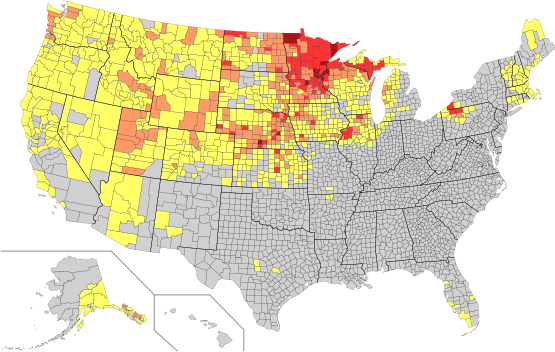The big immigration Posted by Katja on Feb 8, 2013 in Uncategorized
Depending on the level of interest in history, most Swedes know a little bit about the big immigration of Swedes to the United States of America during the late eighteen hundreds.
Sweden was said to be a dark and cold place befallen by several years of crop failure in a row. During the eighteen and early nineteen hundreds, just about towards the end of the Age of Enlightenment there were a lot of different groups of people who didn’t have a place in the Swedish society.
The church ruled Sweden with an iron grip, leaving no room for opinion or free thinking. Poor farmers had to pay taxes even though they had no money to pay with, people were starving and the fields were filled with nothing but rocks. On top of this the Swedish population had grown a lot and people were having a hard time surviving.
A couple of daring Swedes followed the ever growing crowds going to America in boats which crossed the Atlantic ocean. They wrote home to their friends and family, talking of open plains of uncultivated soil and of freedom of speech and religion. To the people starving in Sweden this sounded like heaven, even though crossing the Atlantic sounds like hell. More and more people started daring to cross the huge ocean and seek their fortune in the land of freedom.
Nobody cared about the very poorest people in Sweden and so many just had enough, didn’t have any other choice but to sell their few belongings and buy tickets across the ocean.
Of course many people got sick and died on the journey over, and Swedes were far from the only people immigrating to the land of dreams. But since most Swedes could in general read and write they were welcomed at the boarders and let through immigration easier than many of the illiterate groups of people seeking new lives.
Once into the country some were met by family who’d come before them, while others sought out the ever growing Swedish settlements. In this foreign land where they didn’t speak the language it was a comfort to find people with who they could talk about Sweden with.
The following picture shows which were the most populated Swedish American states year 2000.
All in all there were about 1,2 to 1,3 million Swedes who immigrated to the US, of which about a fifth returned to Sweden at some point in their life.
The American government made stricter regulations about immigration around 1920 making it harder for people to enter the country. The big period of immigration is usually estimated from about the mid 1880’s to year 1915.
If you want to know more about the journey across the ocean, how people built their new lives etc. there is a very famous book written by Vilhelm Moberg, called Utvandrarna and a sequel called Invandrarna. The books have also been made into a movie called Utvandarna, directed by Jan Troell 1971.
The following post will be about generations today wanting to know more about their ancestry. Look forward to the continued adventure.

Build vocabulary, practice pronunciation, and more with Transparent Language Online. Available anytime, anywhere, on any device.





Comments:
Allison Shields:
My grandfather immigrated to America on a whaling boat…a lot of fun history. Tack så mycket!
Gabriella L Garlock:
I just read Moberg’s Immigrants series recently–and was blown away! Sometimes you expect the novels written before you were born to be somewhat dry and prosaic, but this was not the case at all. The characters are engaging, the plot in many places gripping–and above all, he really captures the contrast between the social/religious rigidity of life in Sweden and the overwhelming freedom in the U.S. Also he addresses the dangerous “myths” or exaggerations about what is good in the U.S., and the displacement of Native Americans.
Every Swedish-American should read these books, and appreciate where their ancestors came from and what they went through, first hand.
Caroline:
Even not long after the second world war, I can remember Swedish people getting on the ships bound for England from Goteborg. They would then, presumably sail on to the States. Their families would be on the quay-side, all weeping. It was truly heartbreaking to see. It is hard to remember that even overseas telephone calls were rare in those days and many people did not anticipate seeing their families again, ever. Hopefully things changed and they did meet up again. I would only have been about eight or nine, even younger, but the grief of the parting seemed dreadful to me.
J. Eric:
Moberg based his writing on real diaries kept by Andrew Peterson, a Swedish American emigrant to Minnesota.
There is The Andrew Peterson Society in both Sweden and America that remembers that great emigration.
Here is the link to the website.
The Andrew Peterson Society
http://www.andrewpeterson.se/eng_moberg.htm
My Great Grandparents sailed from Goteborg in April of 1882. Their names were Eric och Christina Lundin. Last year I visited Sweden for the third time and saw both the homes they were born in, still standing.
I am a proud Great Grandson of Swedes.
lancel soldes:
Because many of us were consequently busy while using the move (and coping with the arrival of a new baby a bit of over thirty days later), we didn¡¯t crop up open those people boxes for a long time.